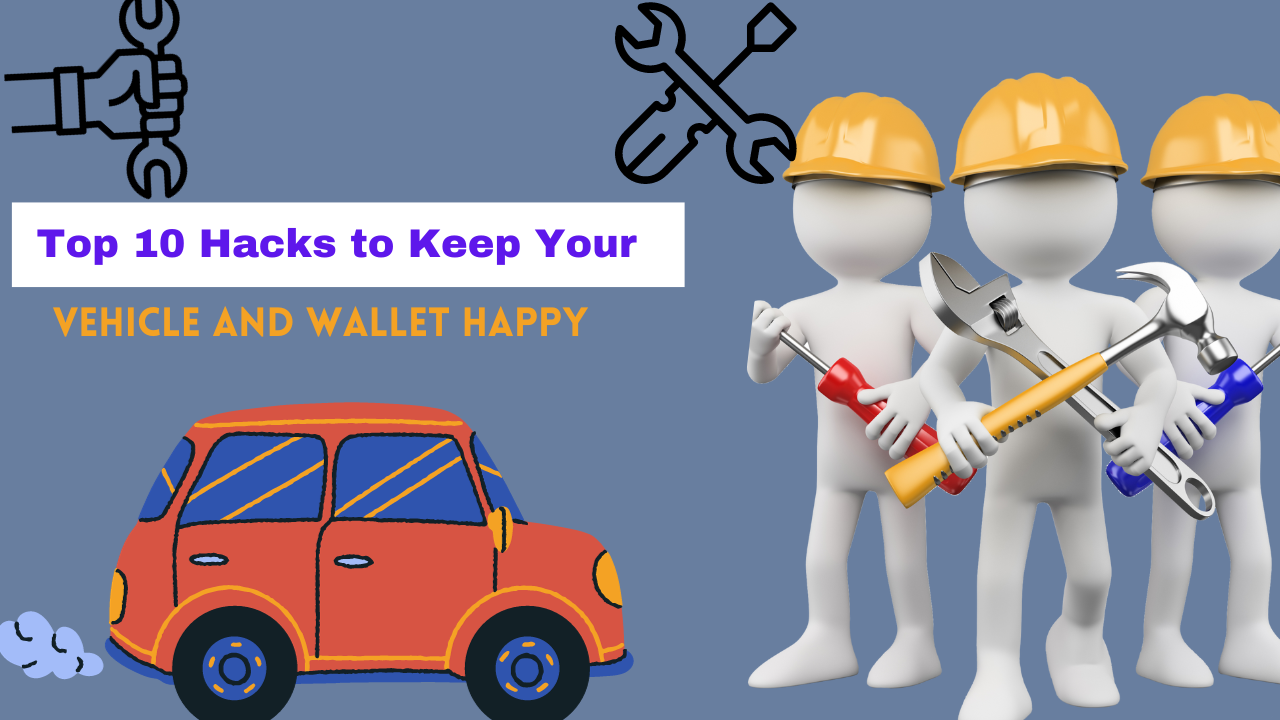Owning a vehicle comes with a set of responsibilities, but it doesn’t have to be a financial burden. Keeping your vehicle in top shape while saving money can be achieved with a few clever hacks. In this article, we’ll explore ten practical tips to ensure your vehicle remains reliable, and your wallet stays a little heavier.
1. Regular Car Maintenance Tips
Why Regular Maintenance Matters
Regular maintenance is the backbone of a happy vehicle and wallet. By conducting routine checks on your vehicle, you can catch issues before they become costly problems. Simple tasks like checking the oil, filters, and fluids can prevent major breakdowns.
How to Perform Regular Maintenance

Image by macrovector on Freepik
You don’t need to be a mechanic to handle basic maintenance. Learning to check and change the oil, inspecting the air filter, and monitoring fluid levels are skills that can save you money and keep your vehicle running smoothly.
2. Optimize Your Driving Habits
Fuel-Efficient Driving Techniques
Efficient driving can significantly impact your fuel consumption. Simple strategies like avoiding aggressive acceleration and maintaining a steady speed can improve your gas mileage and extend the life of your vehicle.
The Impact of Aggressive Driving
Erratic driving habits, such as excessive speeding and sudden braking, not only increase the risk of accidents but also lead to increased fuel consumption. By practicing calm and predictable driving, you can reduce wear and tear on your vehicle and your finances.
3. Choose the Right Fuel
Understanding Fuel Types
Understanding the types of fuel available and what your vehicle requires is crucial. Using the wrong fuel can harm your engine’s performance and efficiency.
How to Choose the Right Fuel
Consult your vehicle’s manual to determine the correct fuel type. Using premium fuel when regular unleaded will suffice is a waste of money, so always follow your manufacturer’s recommendations.
4. Tire Care and Efficiency
Proper Tire Inflation
Maintaining the right tire pressure is vital for fuel efficiency. Underinflated tires increase rolling resistance, making your engine work harder and consume more fuel.
Tire Rotation and Balance
Regularly rotating and balancing your tires ensures even wear and prolongs their lifespan, saving you money in the long run.
5. Reduce Unnecessary Weight
The Impact of Excess Weight
Carrying unnecessary weight in your vehicle reduces fuel efficiency. Clear out your trunk and remove roof racks when they’re not in use to lighten the load.
Tips for Reducing Weight
Carry only what’s essential, and don’t use your car as a storage space. Lightening your vehicle’s load can make a noticeable difference in your fuel economy.
6. Parking Smart
Safe Parking Practices
Selecting the right parking spot is the first step in ensuring your safety. Consider the following factors:
- Well-Lit Area: Opt for spots in well-lit areas, especially at night.
- Proximity to Destination: Park as close to your destination as possible to reduce the need for long walks.
- Visibility: Choose a spot that provides good visibility for entering and exiting.
- Avoid Obstacles: Look for spots that are free from obstacles like shopping carts or debris.
Parking Lot Safety
In parking lots, be aware of pedestrians and other vehicles. Follow these guidelines:
- Slow Down: Reduce your speed when driving through parking lots.
- Pedestrian Right of Way: Yield to pedestrians, and be especially cautious around children.
- No Distractions: Avoid distractions like texting or talking on the phone.
- Follow Markings: Obey parking lot markings and signs.
Parallel Parking
Parallel parking can be challenging for some, but these steps can make it easier:
- Pull Up Beside the Car in Front: Align your car’s rear bumper with the front bumper of the car in front.
- Turn the Wheel Towards the Curb: Turn your steering wheel all the way to the right.
- Slowly Reverse: Gently reverse into the parking space.
- Straighten Out: When your car is at a 45-degree angle, straighten your wheels.
- Pull Forward: Pull forward to center your car in the parking space.
Remember that safe parking practices not only protect your vehicle but also ensure the safety of pedestrians and other drivers. Always be considerate and follow the rules to make parking a stress-free and secure experience.
Also read: 14 Tips for Saving Money for Dream Vacations – A Guide to Make Your Travel Dreams Come True
The Impact of Parking on Fuel Efficiency
Parking in the shade can keep your vehicle cooler, reducing the need for air conditioning. This small change can save you money on fuel and improve your car’s comfort.
7. Regular Cleaning and Care
The Importance of Vehicle Cleanliness
Regularly cleaning your vehicle not only keeps it looking good, but also protects the paint and finishes from damage. Neglecting cleanliness can lead to costly bodywork and repairs.
DIY Car Care Tips
Learn basic car care techniques, such as washing, waxing, and interior cleaning, to maintain your vehicle’s appearance and value without breaking the bank.
8. Upgrading for Efficiency
Modern Fuel-Efficient Technologies
Consider upgrading to a more fuel-efficient vehicle if your current one is old and guzzles gas. Modern cars often come with advanced technologies that can significantly improve fuel efficiency.
Smart Car Maintenance
| Maintenance Aspect | Description |
|---|---|
| Oil Change | Change every 3,000 to 5,000 miles |
| Tire Pressure | Check monthly and maintain recommended levels |
| Air Filter | Replace every 12,000 to 15,000 miles |
| Brake Inspection | Inspect every 10,000 to 20,000 miles |
| Fluid Levels | Regularly check and top up as needed |
| Spark Plugs | Replace every 30,000 miles or as per manufacturer |
When and How to Upgrade
Before upgrading, calculate the potential savings and weigh them against the cost of purchasing a new vehicle. Ensure that the benefits outweigh the expenses.
9. Frequently Asked Questions
- Can I perform regular maintenance checks on my own, even if I’m not a car expert?
- Yes, many basic maintenance tasks can be done by anyone with a little guidance and the right tools.
- Is fuel-efficient driving really that important for saving money?
- Absolutely. Efficient driving can significantly reduce your fuel expenses and extend the life of your vehicle.
- How can I tell which fuel type is right for my car?
- Refer to your vehicle’s manual for the manufacturer’s recommendations.
- Why is tire care essential for saving money on my vehicle?
- Proper tire care can improve fuel efficiency and extend the life of your tires, saving you money in the long run.
- When should I consider upgrading to a more fuel-efficient vehicle?
- Consider upgrading when the potential fuel savings outweigh the cost of purchasing a new car, and it fits your budget.
10. Conclusion
A Happy Vehicle and Wallet Await
By now, you should be convinced that smart car maintenance is not only good for your vehicle but also excellent for your financial health. So, take the first step in maximizing your car’s lifespan and your savings. Start implementing these smart car maintenance tips today, and watch your wallet thank you for it in the long run.





